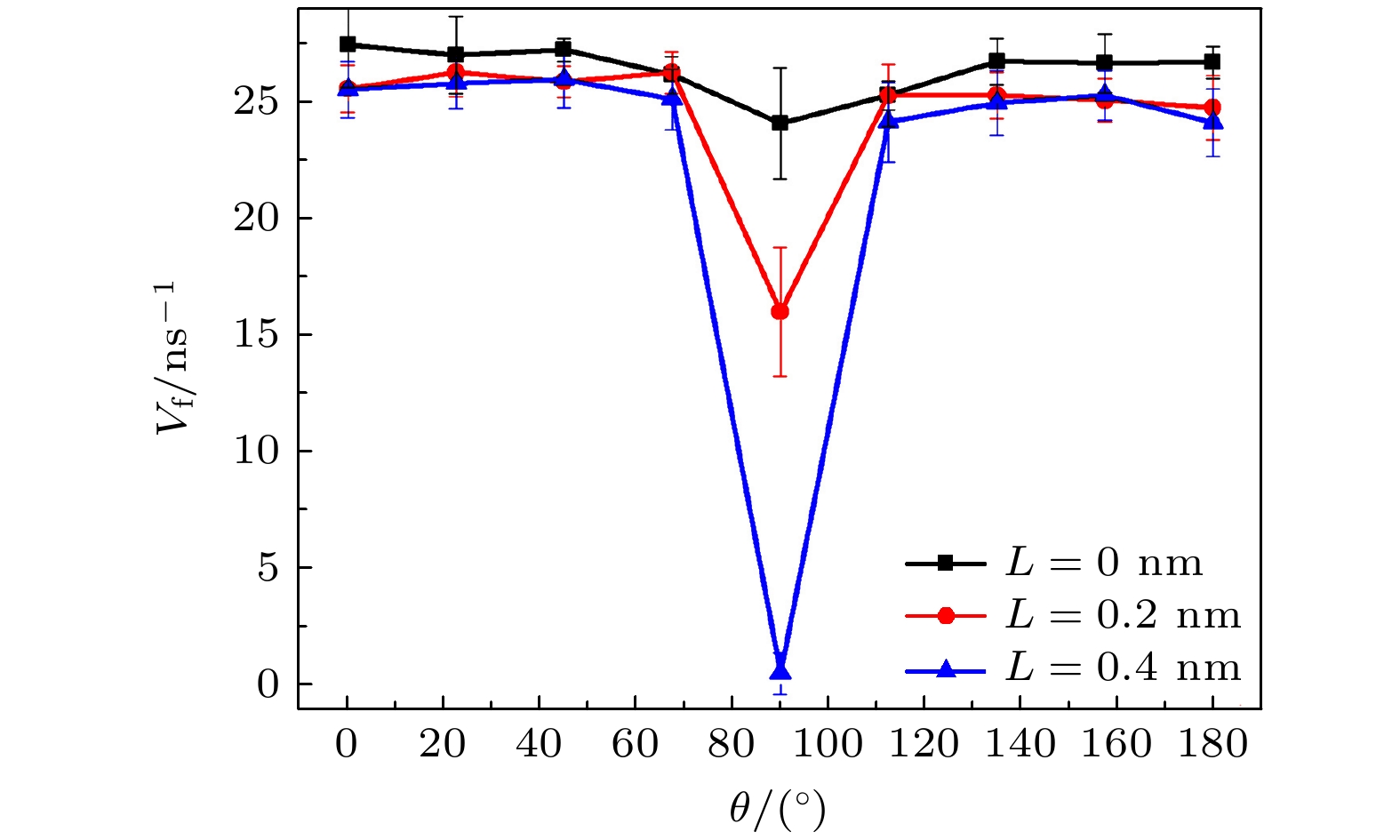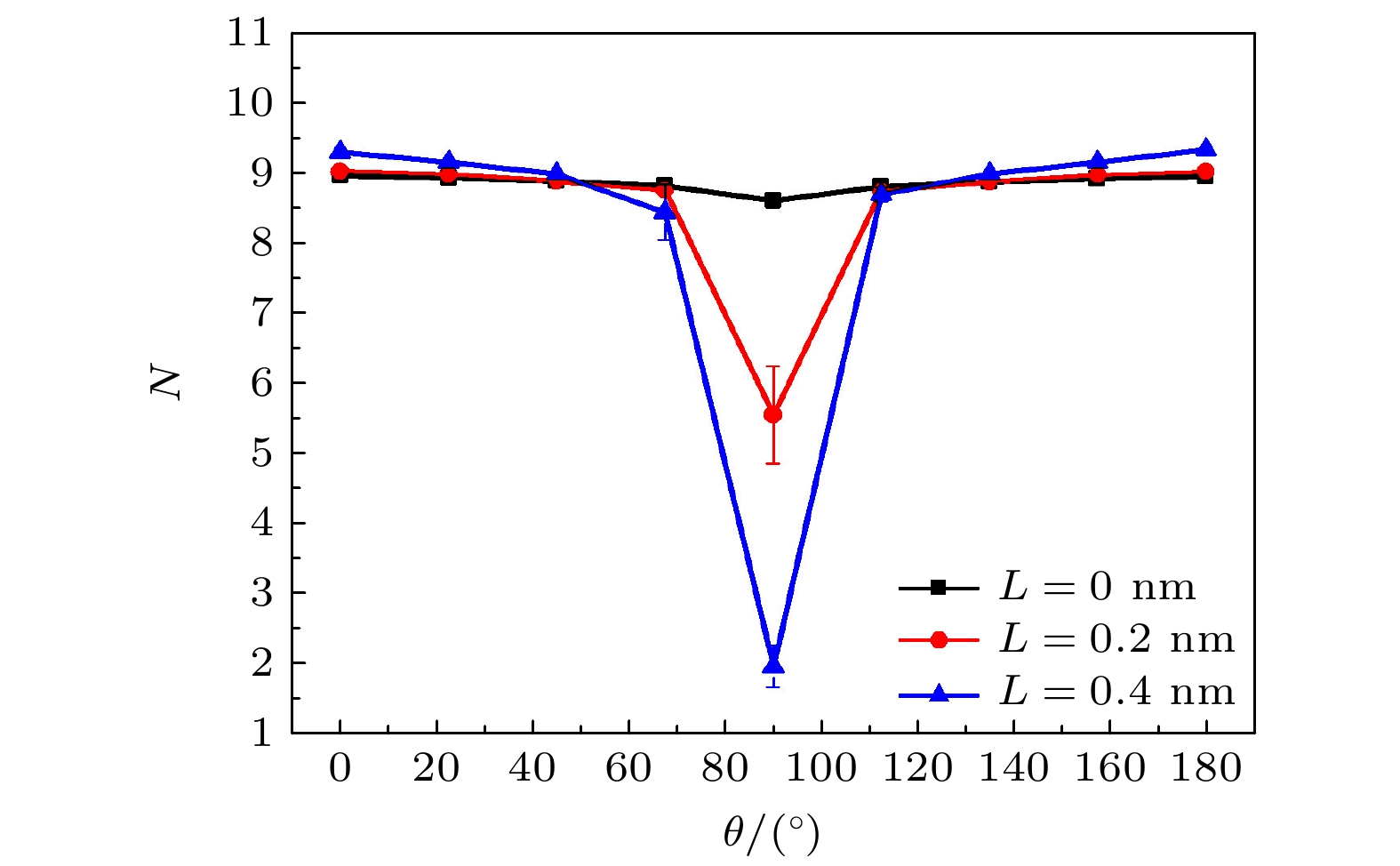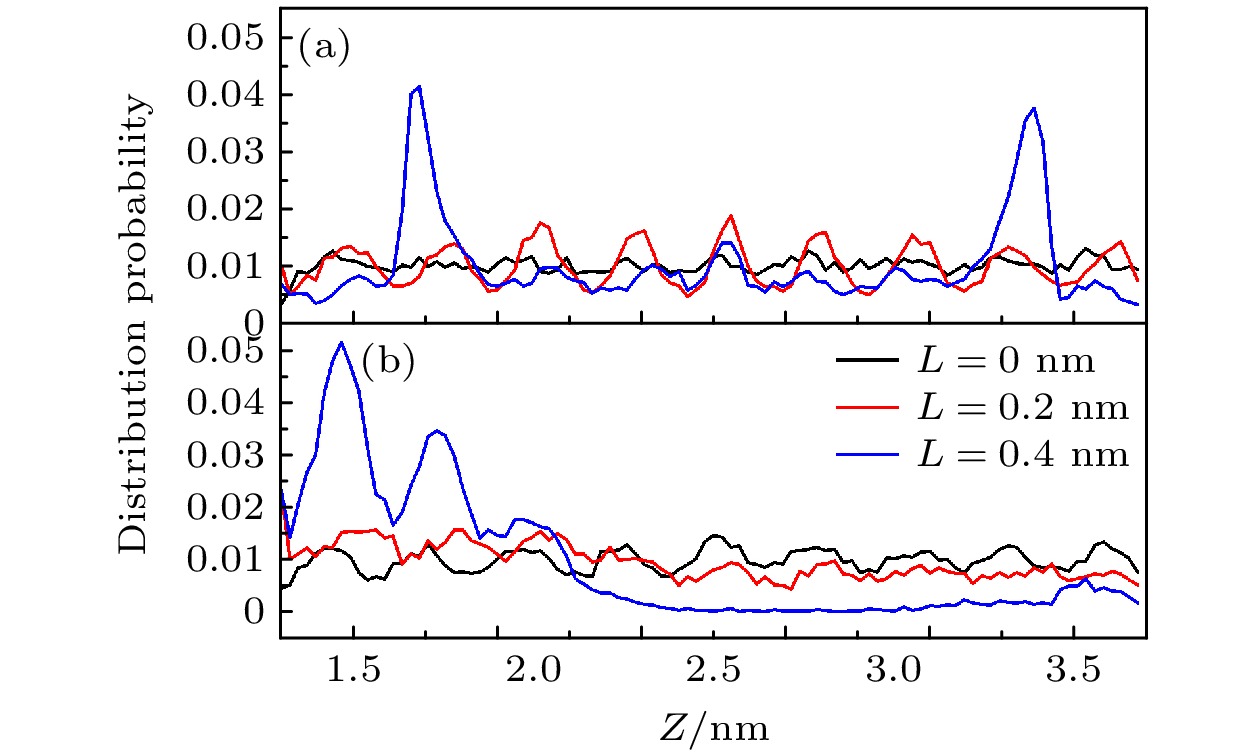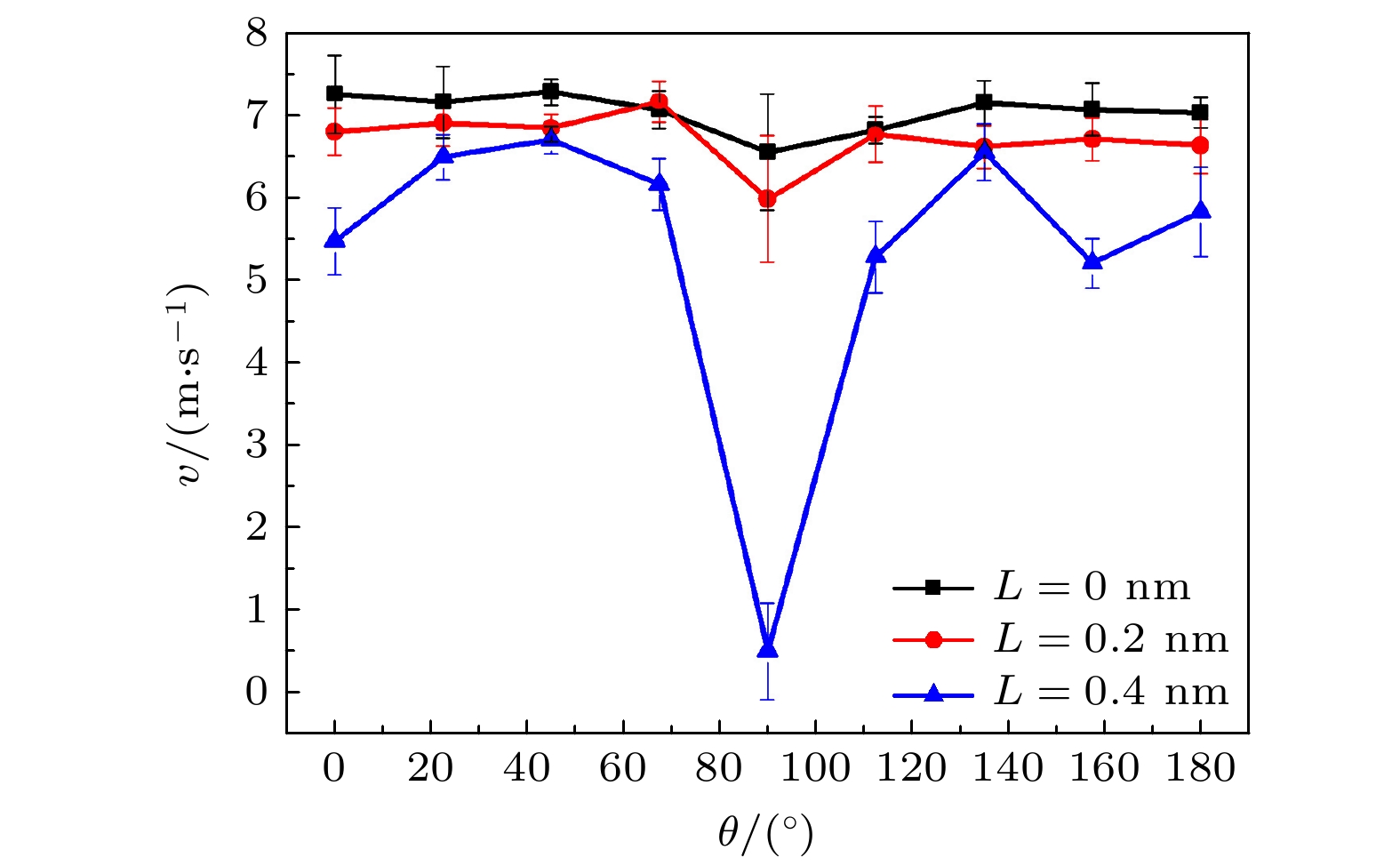-
电场影响纳米通道内的水分子的电偶极矩取向, 进而影响纳米通道内的水分子的传输. 为了有效发掘水分子在纳米通道内的传输特点, 必须研究更复杂的纳米通道结构. 最新一种构造复杂纳米通道的方式是构造断裂纳米通道. 在研究断裂纳米通道内的水分子的动力学特点时, 通常是在零电场或单一电场方向下进行的, 电场方向对断裂纳米通道内的水分子的影响机理尚不明确, 这制约了部分场控分子器件的设计. 为了探究该问题, 本文采用分子动力学模拟方法, 系统研究了电场方向从0°变化到180°的过程中, 电场方向对完整纳米通道以及断裂长度分别为0.2和0.4 nm的断裂纳米通道内的水分子的占据数、传输、水桥、电偶极矩偏向等性质的影响. 结果表明, 在1 V/nm的电场强度作用下, 这三种纳米通道内的水分子的占据数、传输等差别主要集中在电场方向与管轴夹角为90°时, 此时完整纳米通道内能形成稳定的水链, 断裂长度为0.2 nm的纳米通道的连接处能形成不稳定的水桥, 而断裂长度为0.4 nm的纳米通道的连接处不能形成水桥. 此外, 模拟发现当电场极化方向与管轴夹角为90°时, 增大电场的强度, 断裂纳米通道连接处的水桥更容易断裂.The orientation of water molecules within nanochannels is pivotal in influencing water transport, particularly under the influence of electric fields. This study delves into the effects of electric field direction on water transport through disjoint nanochannels, a structure which is of emerging significance. Molecular dynamics simulations are conducted to study the properties of water in complete nanochannel and disjoint nanochannels with gap sizes of 0.2 nm and 0.4 nm, respectively, such as occupancy, transport, water bridge formation, and dipole orientation, by systematically varying the electric field direction from 0 to 180 degrees. The simulation results disclose that the electric field direction has little influence on water flow through complete nanochannels. However, as the size of the nanogap expands, the declining trend of water transfer rate through disjoint nanochannels becomes more distinctive when the electric field direction is shifted from 0 to 90 degrees under an electric field with a strength of 1 V/nm. Notably, results also reveal distinct behaviors at 90 degrees under an electric field with a strength of 1 V/nm, where the stable water chains, unstable water bridges, and no water bridges are observed in complete nanochannels, disjoint nanochannels with 0.2 nm gap, and 0.4 nm gap, respectively. Moreover, simulations indicate that increasing the electric field strength in a polarization direction perpendicular to the tube axis facilitates water bridge breakdown in disjoint nanochannels. This research sheds light on the intricate interplay between electric field direction and water transport dynamics in disjoint nanochannels, presenting valuable insights into various applications.
-
Keywords:
- electric field /
- disjoint nanochannels /
- direction
[1] Fajardo-Diaz J L, Morelos-Gomez A, Cruz-Silva R, Ishii K, Yasuike T, Kawakatsu T, Yamanaka A, Tejima S, Izu K, Saito S, Maeda J, Takeuchi K, Endo M 2022 Chem. Eng. J. 448 137359
 Google Scholar
Google Scholar
[2] Kang X, Meng X W 2022 Chem. Phys. 559 111544
 Google Scholar
Google Scholar
[3] Corry B 2008 J. Phys. Chem. B 112 1427
 Google Scholar
Google Scholar
[4] Zhang R N, Liu Y N, He M R, Su Y L, Zhao X T, Elimelech M, Jiang Z Y 2016 Chem. Soc. Rev. 45 5888
 Google Scholar
Google Scholar
[5] Werber J R, Osuji C O, Elimelech M 2016 Nat. Rev. Mater. 1 16018
 Google Scholar
Google Scholar
[6] Abramyan A K, Bessonow N M, Mirantsev L V, Chevrychkina A A 2018 Eur. Phys. J. B 91 48
 Google Scholar
Google Scholar
[7] Park H G, Jung Y 2014 Chem. Soc. Rev. 43 565
 Google Scholar
Google Scholar
[8] 孙志伟, 何燕, 唐元政 2021 物理学报 70 060201
 Google Scholar
Google Scholar
Sun Z W, He Y, Tang Y Z 2021 Acta Phys. Sin. 70 060201
 Google Scholar
Google Scholar
[9] Qiu T, Meng X W, Huang J P 2015 J. Phys. Chem. B 119 1496
 Google Scholar
Google Scholar
[10] Holt J K, Park H G, Wang Y M, Stadermann M, Artyukhin A B, Grigoropoulos C P, Noy A, Bakajin O 2006 Science 312 1034
 Google Scholar
Google Scholar
[11] Hummer G, Rasaiah J C, Noworyta J P 2001 Nature 414 188
 Google Scholar
Google Scholar
[12] Secchi E, Marbach S, Nigues A, Stein D, Siria A, Bocquet L 2016 Nature 537 210
 Google Scholar
Google Scholar
[13] Farrokhbin M, Lohrasebi A 2023 Eur. Phys. J. E 46 93
 Google Scholar
Google Scholar
[14] He Y C, Sun G, Koga K, Xu L M 2014 Sci. Rep. 4 6596
 Google Scholar
Google Scholar
[15] Liu W C, Jing D W 2023 J. Phys. Chem. Lett. 14 5740
 Google Scholar
Google Scholar
[16] Wang Y, Zhao Y J, Huang J P 2011 J. Phys. Chem. B 115 13275
 Google Scholar
Google Scholar
[17] Zhang Q L, Yang R Y, Jiang W Z, Huang Z Q 2016 Nanoscale 8 1886
 Google Scholar
Google Scholar
[18] Zhang Q L, Yang R Y 2016 Chem. Phys. Lett. 644 201
 Google Scholar
Google Scholar
[19] Zhu J Z, Lan Y Q, Du H J, Zhang Y H, Su J G 2016 Phys. Chem. Chem. Phys. 18 17991
 Google Scholar
Google Scholar
[20] Shafiei M, Von Domaros M, Bratko D, Luzar A 2019 J. Chem. Phys. 150 074505
 Google Scholar
Google Scholar
[21] Vanzo D, Luzar A, Bratko D 2021 Phys. Chem. Chem. Phys. 23 27005
 Google Scholar
Google Scholar
[22] 张忠强, 李冲, 刘汉伦, 葛道晗, 程广贵, 丁建宁 2018 物理学报 67 056102
 Google Scholar
Google Scholar
Zhang Z Q, Li C, Liu H L, Ge D H, Cheng G G, Ding J N 2018 Acta Phys. Sin. 67 056102
 Google Scholar
Google Scholar
[23] 章其林, 王瑞丰, 周同, 王允杰, 刘琪 2023 物理学报 72 084207
 Google Scholar
Google Scholar
Zhang Q L, Wang R F, Zhou T, Wang Y J, Liu Q 2023 Acta Phys. Sin. 72 084207
 Google Scholar
Google Scholar
[24] de Freitas D N, Mendonca B H S, Kohler M H, Barbosa M C, Matos M J S, Batista R J C, de Oliveira A B 2020 Chem. Phys. 537 110849
 Google Scholar
Google Scholar
[25] Sahimi M, Ebrahimi F 2019 Phys. Rev. Lett. 122 214506
 Google Scholar
Google Scholar
[26] Meng X W, Shen L 2020 Chem. Phys. Lett. 739 137029
 Google Scholar
Google Scholar
[27] Ebrahimi F, Maktabdaran G R, Sahimi M 2020 J. Phys. Chem. B 124 8340
 Google Scholar
Google Scholar
[28] Meng X W, Li Y, Shen L, Yang X Q 2020 EPL 131 20003
 Google Scholar
Google Scholar
[29] Meng X W, Li Y 2022 Physica E 135 114980
 Google Scholar
Google Scholar
[30] Wang F, Zhang X K, Li S, Su J Y 2022 J. Mol. Liq. 362 119719
 Google Scholar
Google Scholar
[31] Hess B, Kutzner C, Van De Spoel D, Lindahl E 2008 J. Chem. Theory. Comp. 4 435
 Google Scholar
Google Scholar
[32] Jorgensen W L, Chandrasekhar J, Madura J D, Impey R W, Klein M L 1983 J. Chem. Phys. 79 926
 Google Scholar
Google Scholar
[33] Nose S 1984 J. Chem. Phys. 81 511
 Google Scholar
Google Scholar
[34] Hoover W G 1985 Phys. Rev. A 31 1695
 Google Scholar
Google Scholar
[35] Wan R Z, Li J Y, Lu H J, Fang H P 2005 J. Am. Chem. Soc. 127 7166
 Google Scholar
Google Scholar
[36] Li J Y, Gong X J, Lu H J, Li D, Fang H P 2007 P. Natl. Acad. Sci. USA 104 3687
 Google Scholar
Google Scholar
[37] Darden T A, York D M, Pedersen L G 1993 J. Chem. Phys. 98 10089
 Google Scholar
Google Scholar
[38] Zhao Y Z, Su J Y 2018 J. Phys. Chem. C 122 22178
 Google Scholar
Google Scholar
[39] Fang C, Huang D C, Su J Y 2020 J. Phys. Chem. Lett. 11 940
 Google Scholar
Google Scholar
[40] Xie Z, Li Z, Li J Y, Kou J L, Yao J, Fan J T 2021 J. Chem. Phys. 154 024705
 Google Scholar
Google Scholar
[41] Xie Z, Hao S Q, Wang W Y, Kou J L, Fan J T 2022 J. Mol. Liq. 363 119852
 Google Scholar
Google Scholar
-
图 1 模拟框架图, 包括2片石墨烯, 1个断裂纳米通道(断裂长度标记为L). 水分子用红白球表示, 石墨烯及断裂纳米通道用青色表示, 电场方向与+z方向的夹角定义为θ
Fig. 1. Configuration of the simulation system. It contains two graphene sheets, a disjoint nanochannel with a nanogap (marked as L). Water molecules are shown in white and red. Carbon atoms are represented in cyan. The angle between the electric field direction and the +z is defined as θ
图 6 (a), (b) θ = 0°时, 完整纳米通道及断裂纳米通道内的水分子的结构图; (c), (d) θ = 90°时, 完整纳米通道及断裂纳米通道内的水分子的结构图
Fig. 6. (a), (b) Structure of water molecules in complete nanochannels and disjoint nanochannels when θ = 0°, respectively; (c), (d) structure of water molecules in complete nanochannels and disjoint nanochannels when θ = 90°, respectively
-
[1] Fajardo-Diaz J L, Morelos-Gomez A, Cruz-Silva R, Ishii K, Yasuike T, Kawakatsu T, Yamanaka A, Tejima S, Izu K, Saito S, Maeda J, Takeuchi K, Endo M 2022 Chem. Eng. J. 448 137359
 Google Scholar
Google Scholar
[2] Kang X, Meng X W 2022 Chem. Phys. 559 111544
 Google Scholar
Google Scholar
[3] Corry B 2008 J. Phys. Chem. B 112 1427
 Google Scholar
Google Scholar
[4] Zhang R N, Liu Y N, He M R, Su Y L, Zhao X T, Elimelech M, Jiang Z Y 2016 Chem. Soc. Rev. 45 5888
 Google Scholar
Google Scholar
[5] Werber J R, Osuji C O, Elimelech M 2016 Nat. Rev. Mater. 1 16018
 Google Scholar
Google Scholar
[6] Abramyan A K, Bessonow N M, Mirantsev L V, Chevrychkina A A 2018 Eur. Phys. J. B 91 48
 Google Scholar
Google Scholar
[7] Park H G, Jung Y 2014 Chem. Soc. Rev. 43 565
 Google Scholar
Google Scholar
[8] 孙志伟, 何燕, 唐元政 2021 物理学报 70 060201
 Google Scholar
Google Scholar
Sun Z W, He Y, Tang Y Z 2021 Acta Phys. Sin. 70 060201
 Google Scholar
Google Scholar
[9] Qiu T, Meng X W, Huang J P 2015 J. Phys. Chem. B 119 1496
 Google Scholar
Google Scholar
[10] Holt J K, Park H G, Wang Y M, Stadermann M, Artyukhin A B, Grigoropoulos C P, Noy A, Bakajin O 2006 Science 312 1034
 Google Scholar
Google Scholar
[11] Hummer G, Rasaiah J C, Noworyta J P 2001 Nature 414 188
 Google Scholar
Google Scholar
[12] Secchi E, Marbach S, Nigues A, Stein D, Siria A, Bocquet L 2016 Nature 537 210
 Google Scholar
Google Scholar
[13] Farrokhbin M, Lohrasebi A 2023 Eur. Phys. J. E 46 93
 Google Scholar
Google Scholar
[14] He Y C, Sun G, Koga K, Xu L M 2014 Sci. Rep. 4 6596
 Google Scholar
Google Scholar
[15] Liu W C, Jing D W 2023 J. Phys. Chem. Lett. 14 5740
 Google Scholar
Google Scholar
[16] Wang Y, Zhao Y J, Huang J P 2011 J. Phys. Chem. B 115 13275
 Google Scholar
Google Scholar
[17] Zhang Q L, Yang R Y, Jiang W Z, Huang Z Q 2016 Nanoscale 8 1886
 Google Scholar
Google Scholar
[18] Zhang Q L, Yang R Y 2016 Chem. Phys. Lett. 644 201
 Google Scholar
Google Scholar
[19] Zhu J Z, Lan Y Q, Du H J, Zhang Y H, Su J G 2016 Phys. Chem. Chem. Phys. 18 17991
 Google Scholar
Google Scholar
[20] Shafiei M, Von Domaros M, Bratko D, Luzar A 2019 J. Chem. Phys. 150 074505
 Google Scholar
Google Scholar
[21] Vanzo D, Luzar A, Bratko D 2021 Phys. Chem. Chem. Phys. 23 27005
 Google Scholar
Google Scholar
[22] 张忠强, 李冲, 刘汉伦, 葛道晗, 程广贵, 丁建宁 2018 物理学报 67 056102
 Google Scholar
Google Scholar
Zhang Z Q, Li C, Liu H L, Ge D H, Cheng G G, Ding J N 2018 Acta Phys. Sin. 67 056102
 Google Scholar
Google Scholar
[23] 章其林, 王瑞丰, 周同, 王允杰, 刘琪 2023 物理学报 72 084207
 Google Scholar
Google Scholar
Zhang Q L, Wang R F, Zhou T, Wang Y J, Liu Q 2023 Acta Phys. Sin. 72 084207
 Google Scholar
Google Scholar
[24] de Freitas D N, Mendonca B H S, Kohler M H, Barbosa M C, Matos M J S, Batista R J C, de Oliveira A B 2020 Chem. Phys. 537 110849
 Google Scholar
Google Scholar
[25] Sahimi M, Ebrahimi F 2019 Phys. Rev. Lett. 122 214506
 Google Scholar
Google Scholar
[26] Meng X W, Shen L 2020 Chem. Phys. Lett. 739 137029
 Google Scholar
Google Scholar
[27] Ebrahimi F, Maktabdaran G R, Sahimi M 2020 J. Phys. Chem. B 124 8340
 Google Scholar
Google Scholar
[28] Meng X W, Li Y, Shen L, Yang X Q 2020 EPL 131 20003
 Google Scholar
Google Scholar
[29] Meng X W, Li Y 2022 Physica E 135 114980
 Google Scholar
Google Scholar
[30] Wang F, Zhang X K, Li S, Su J Y 2022 J. Mol. Liq. 362 119719
 Google Scholar
Google Scholar
[31] Hess B, Kutzner C, Van De Spoel D, Lindahl E 2008 J. Chem. Theory. Comp. 4 435
 Google Scholar
Google Scholar
[32] Jorgensen W L, Chandrasekhar J, Madura J D, Impey R W, Klein M L 1983 J. Chem. Phys. 79 926
 Google Scholar
Google Scholar
[33] Nose S 1984 J. Chem. Phys. 81 511
 Google Scholar
Google Scholar
[34] Hoover W G 1985 Phys. Rev. A 31 1695
 Google Scholar
Google Scholar
[35] Wan R Z, Li J Y, Lu H J, Fang H P 2005 J. Am. Chem. Soc. 127 7166
 Google Scholar
Google Scholar
[36] Li J Y, Gong X J, Lu H J, Li D, Fang H P 2007 P. Natl. Acad. Sci. USA 104 3687
 Google Scholar
Google Scholar
[37] Darden T A, York D M, Pedersen L G 1993 J. Chem. Phys. 98 10089
 Google Scholar
Google Scholar
[38] Zhao Y Z, Su J Y 2018 J. Phys. Chem. C 122 22178
 Google Scholar
Google Scholar
[39] Fang C, Huang D C, Su J Y 2020 J. Phys. Chem. Lett. 11 940
 Google Scholar
Google Scholar
[40] Xie Z, Li Z, Li J Y, Kou J L, Yao J, Fan J T 2021 J. Chem. Phys. 154 024705
 Google Scholar
Google Scholar
[41] Xie Z, Hao S Q, Wang W Y, Kou J L, Fan J T 2022 J. Mol. Liq. 363 119852
 Google Scholar
Google Scholar
计量
- 文章访问数: 4019
- PDF下载量: 158
- 被引次数: 0













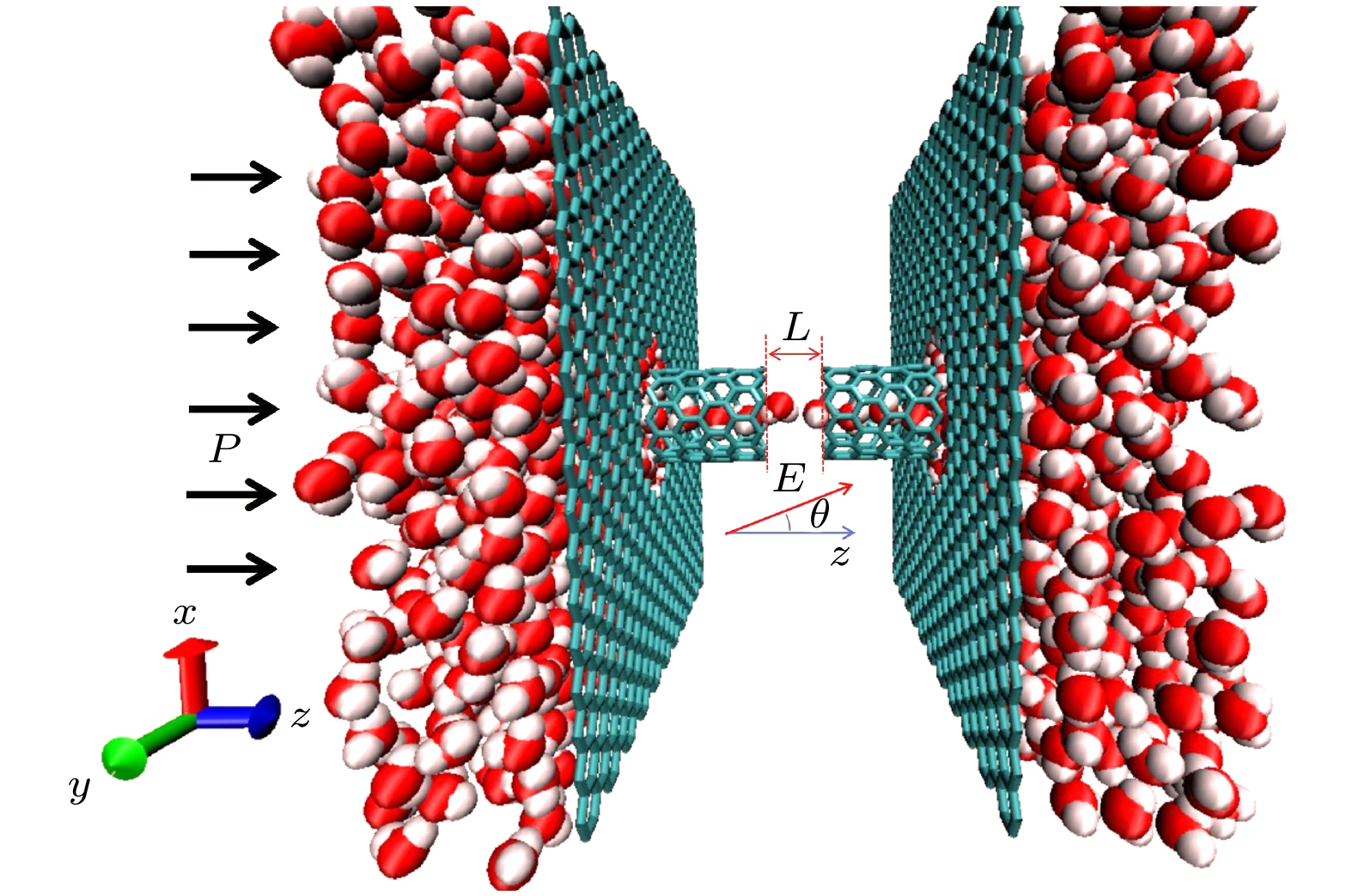
 下载:
下载:
